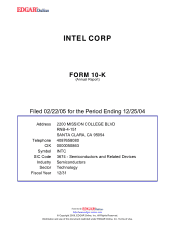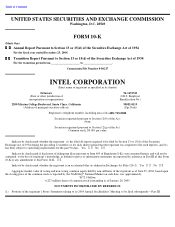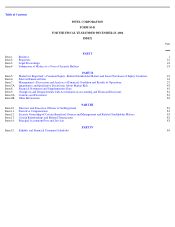Intel 2004 Annual Report Download - page 9
Download and view the complete annual report
Please find page 9 of the 2004 Intel annual report below. You can navigate through the pages in the report by either clicking on the pages listed below, or by using the keyword search tool below to find specific information within the annual report.
Table of Contents
In August 2004, we launched new server platforms based on the 64-bit Intel Xeon processor at 3.6 GHz. These DP-capable platforms
include the new Intel
®
E7520 and Intel
®
E7320 chipsets, which support DDR2 memory capability and feature an 800-MHz bus and PCI
Express, as well as the new Intel
®
332 Storage I/O Processor, which improves storage performance over previous generations.
In October 2004, we unveiled the Low Voltage Intel Xeon processor 2.8 GHz, supporting an 800-MHz bus. Featuring Intel Extended
Memory 64 Technology, this processor is aimed specifically at storage applications, such as controllers for storage networks.
In April 2004, we broadened the Itanium 2 processor family with a 1.4-GHz processor, followed by a 1.6-GHz version in May 2004.
Both processors feature 3 MB of L3 cache and are designed to enable affordable DP systems.
In November 2004, we further enhanced the Itanium 2 processor lineup with six new processors for MP, DP and low-voltage (LV)
systems. The 1.6-GHz Itanium 2 processor MP features 9 MB or 6 MB of L3 cache. The 1.5-GHz Itanium 2 processor MP has 4 MB of L3
cache, and the Itanium 2 processor DP at 1.6 GHz has 3 MB of L3 cache and is available with support for a 400- or 533-MHz bus. Finally, the
Itanium 2 processor LV at 1.3 GHz features 3 MB of L3 cache and is optimized for low-cost systems with dense form factors.
Intel Communications Group
Within ICG, we are focused on developing component-level products for the wireless handheld computing and communications market
segments. These products include flash memory, applications processors and cellular baseband chipsets. We also are developing products that
we believe will help continue to build out the Internet. These products include communications infrastructure components, including network
and embedded processors; wired and wireless connectivity products; and networked storage components.
Net revenue for ICG made up approximately 15% of our consolidated net revenue in 2004. Revenue from sales of flash memory within
ICG represented approximately 7% of consolidated net revenue in 2004.
Flash Memory
Flash memory is a specialized type of memory component used to store user data and program code; it retains this information even when
the power is off. Flash memory is based on either NOR or NAND architectures. Our flash memory is based on the NOR architecture. NOR
flash memory, with its fast “read” capabilities, has traditionally been used to store executable code. NAND flash memory, which is slower in
reading data but faster in writing data, has traditionally been used in products that either required large storage capacity or fast write
applications, such as MP3 music players, memory cards and digital cameras. In addition to having offerings that meet the needs of cellular
customers, we offer flash memory products that meet the needs of other market segments, such as the broad market segment. The broad market
segment includes flash memory products found in various applications, including set-top boxes, networking products and other devices such as
DVD players and DSL cable modems.
Intel StrataFlash
®
Wireless Memory technology allows two bits of data to be stored in each memory cell, for higher storage capacity and
lower cost. It is available in Intel stacked chip-scale packaging and is being developed in Intel ultra-thin stacked chip-scale packaging. This
technology allows up to five ultra-thin memory chips to be stacked in one package, delivering greater memory capacity and lower power
consumption in a smaller package. With heights as low as 1.0mm, the package allows manufacturers to increase memory density and provide
features such as camera capabilities, games and e-mail in relatively thin cell phones. Our higher density flash products generally incorporate
stacked Static Random Access Memory (SRAM), which we purchase from third-party vendors.
Application Processors and Components for Handheld Computing and Communications Devices
In application processing, products based on Intel XScale
®
technology provide the processing capability in data-enabled mobile phones
and PDAs.
In April 2004, we introduced the Intel
®
PXA27x family of application processors. Designed for advanced cell phones and PDAs, the
processors integrate Intel
®
Wireless MMX
™
technology for advanced 3D gaming and video, along with Wireless Intel SpeedStep
®
Power
Manager technology for longer battery life. This processor family is available in a range of clock speeds, from 312 MHz to 624 MHz, and with
as much as 64 MB of stacked Intel StrataFlash memory. The Intel
®
2700G multimedia accelerator, optimized to complement the Intel PXA27x
processor family, is designed to deliver advanced video and graphics capabilities to enable full-screen video at full frame rates without
sacrificing battery life.
6






















